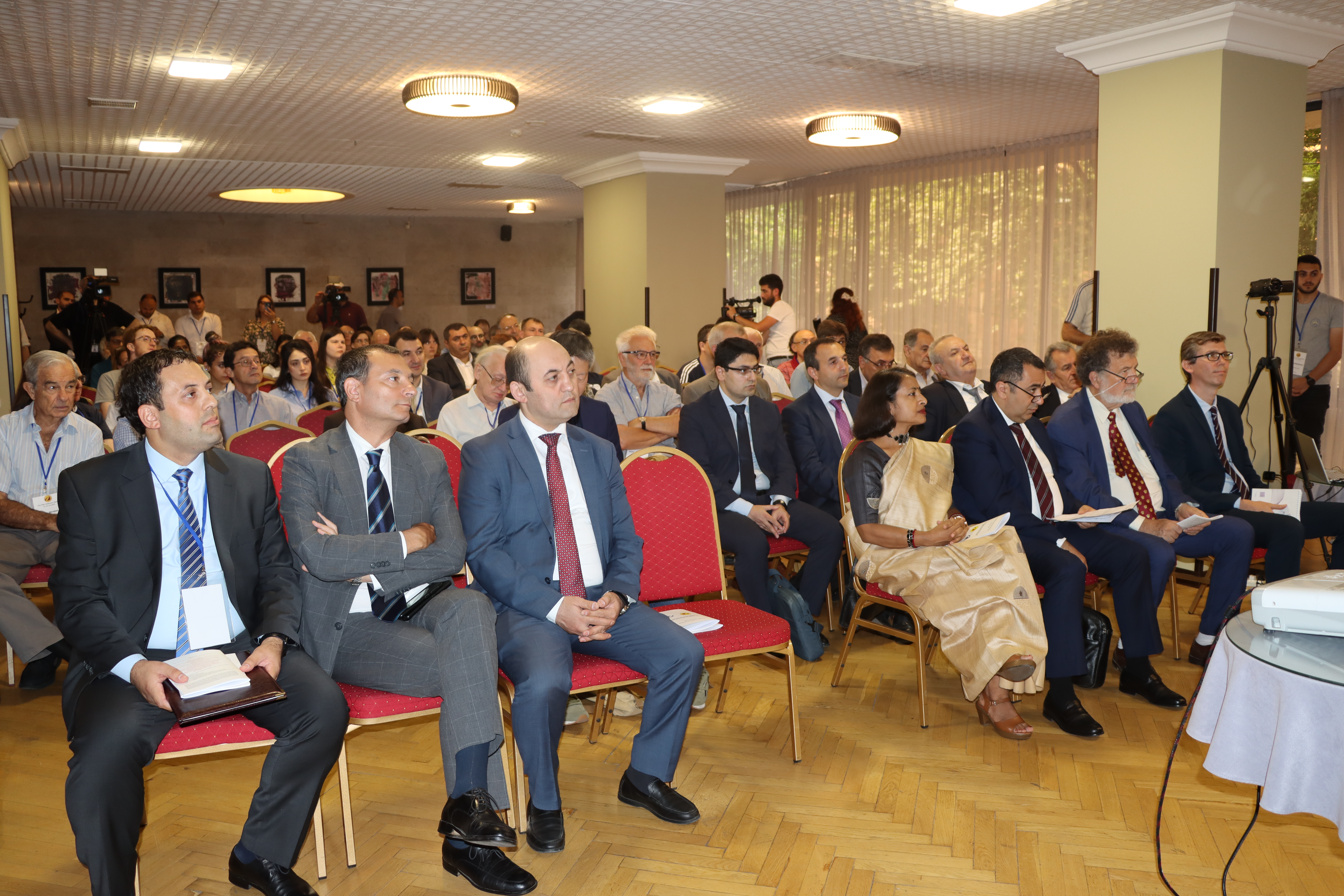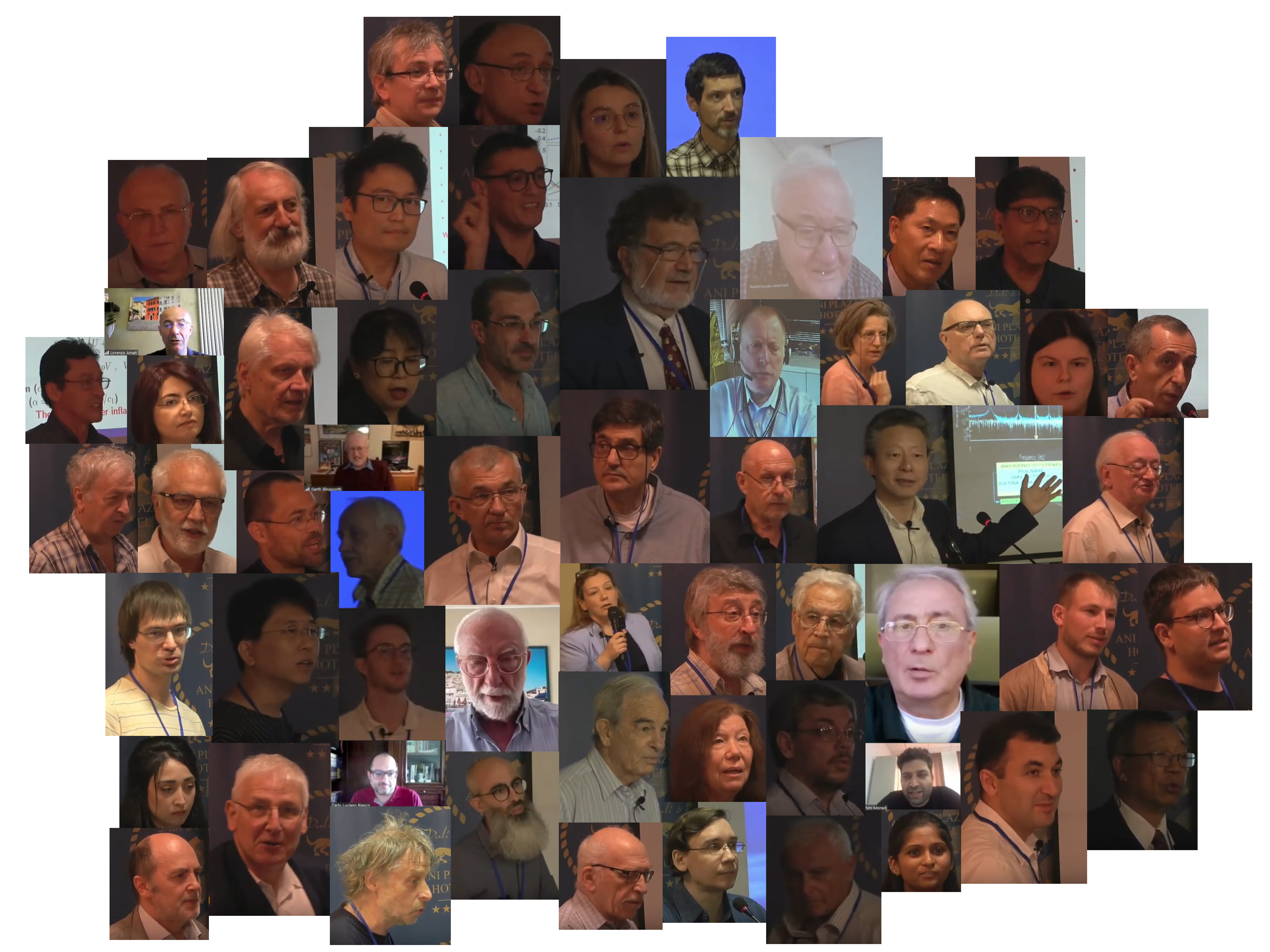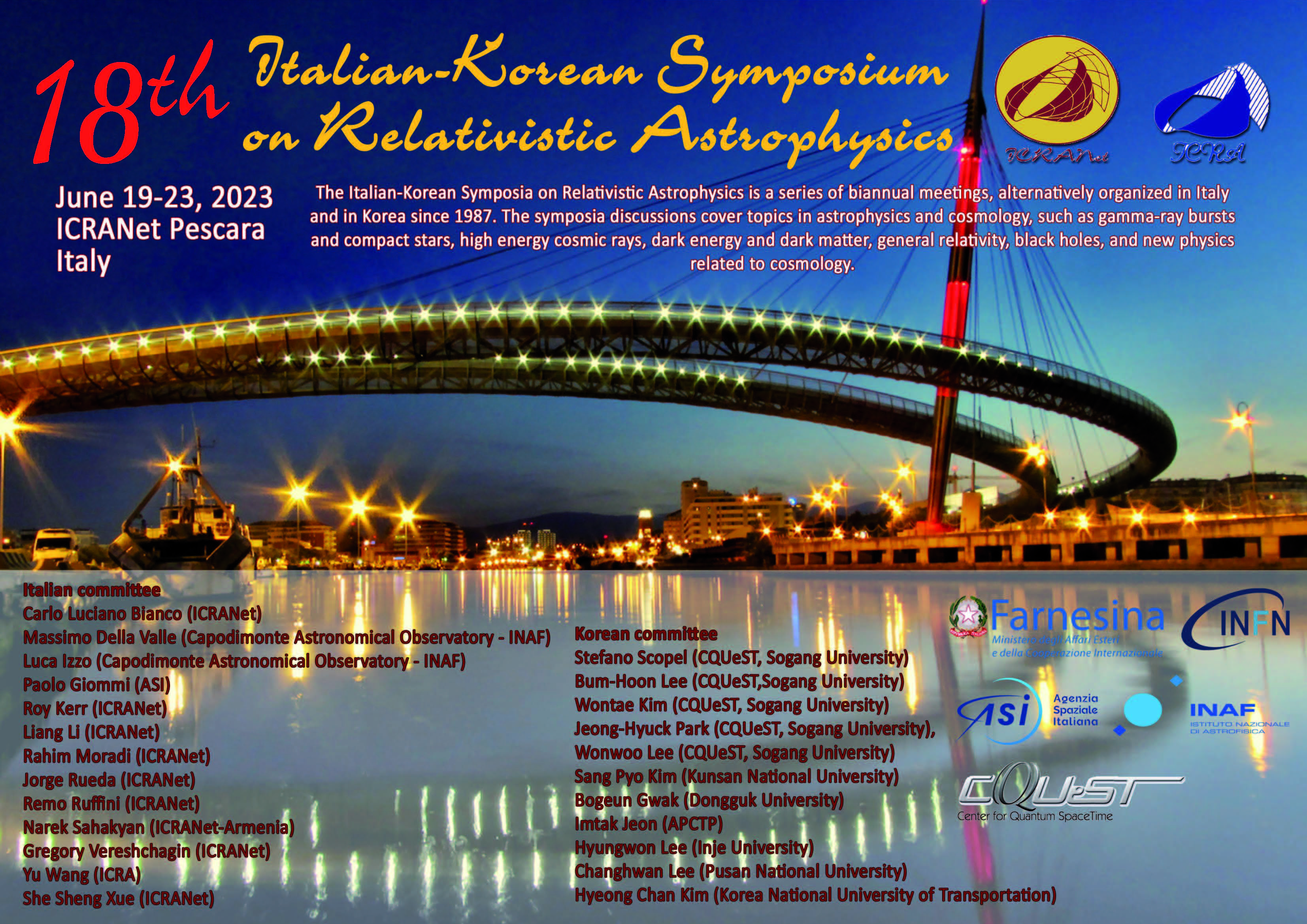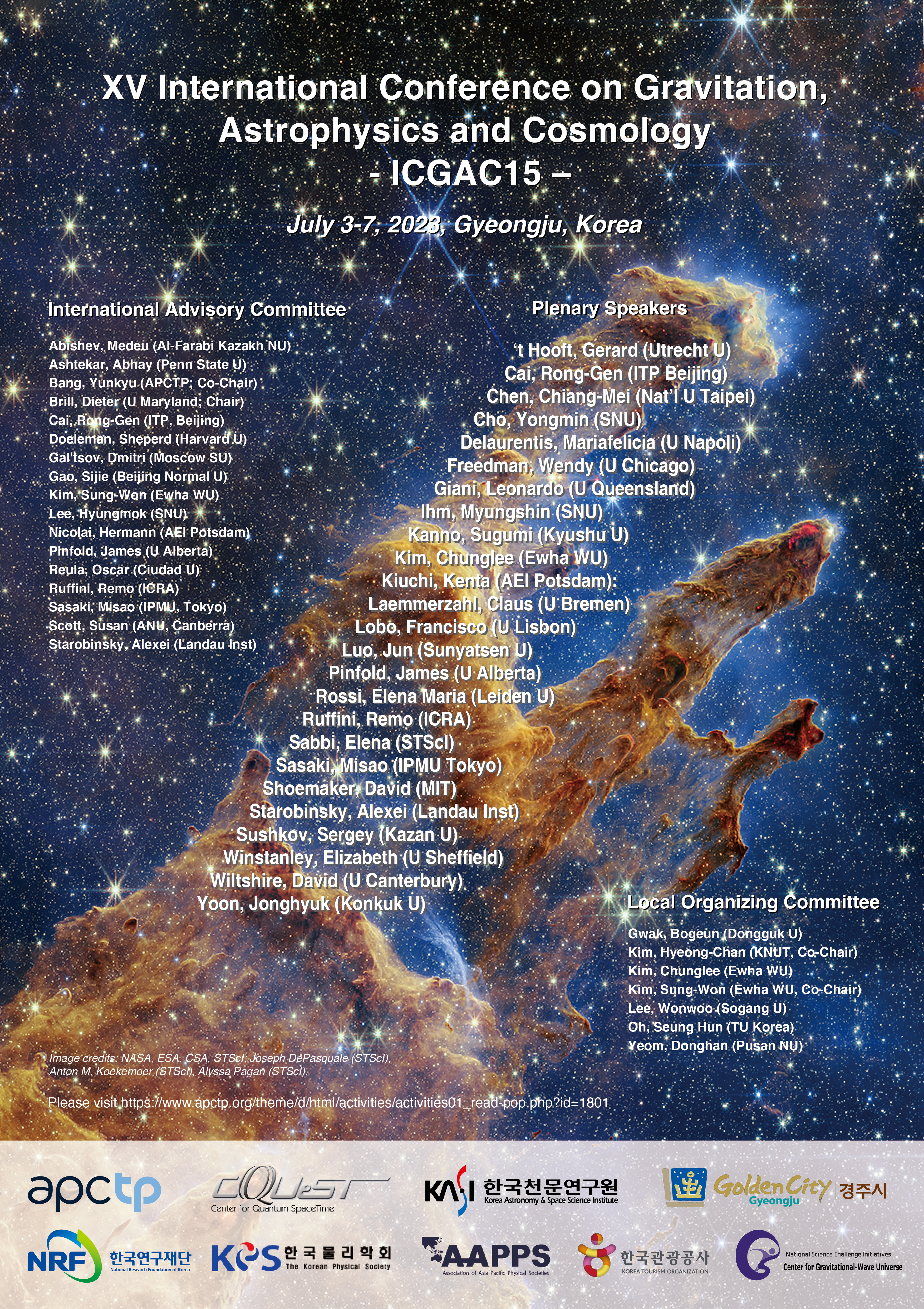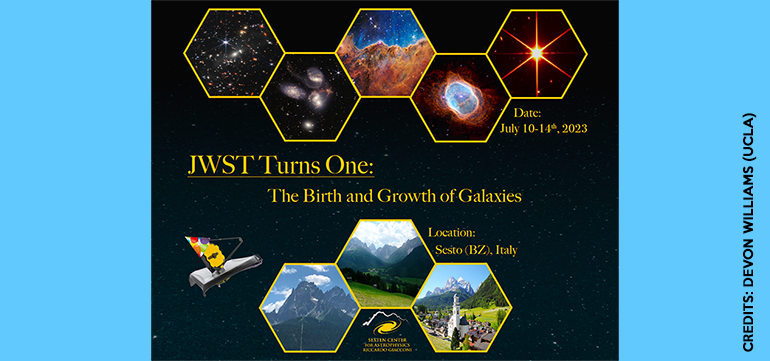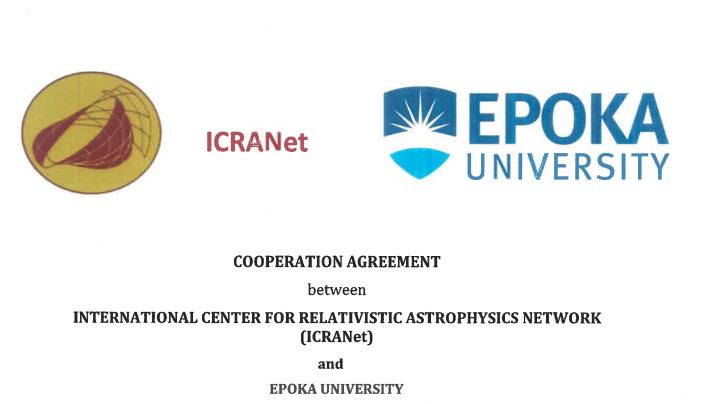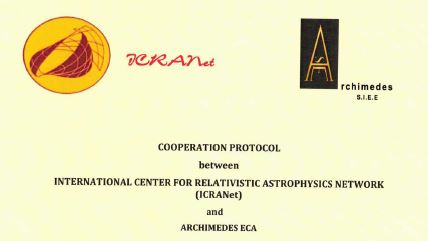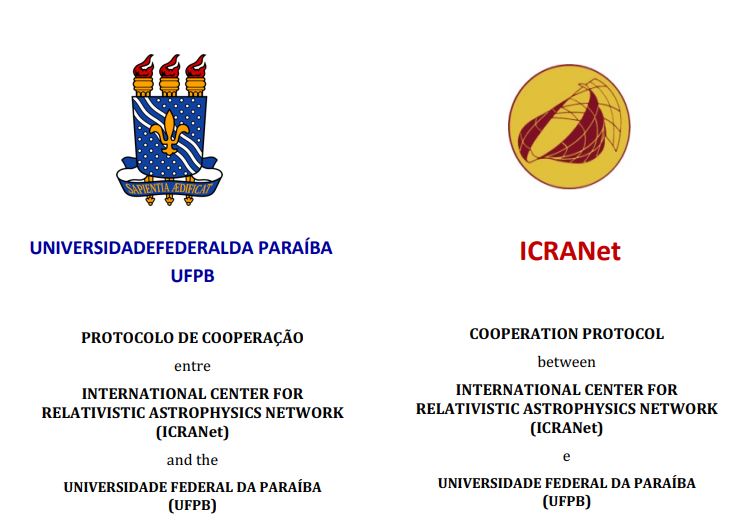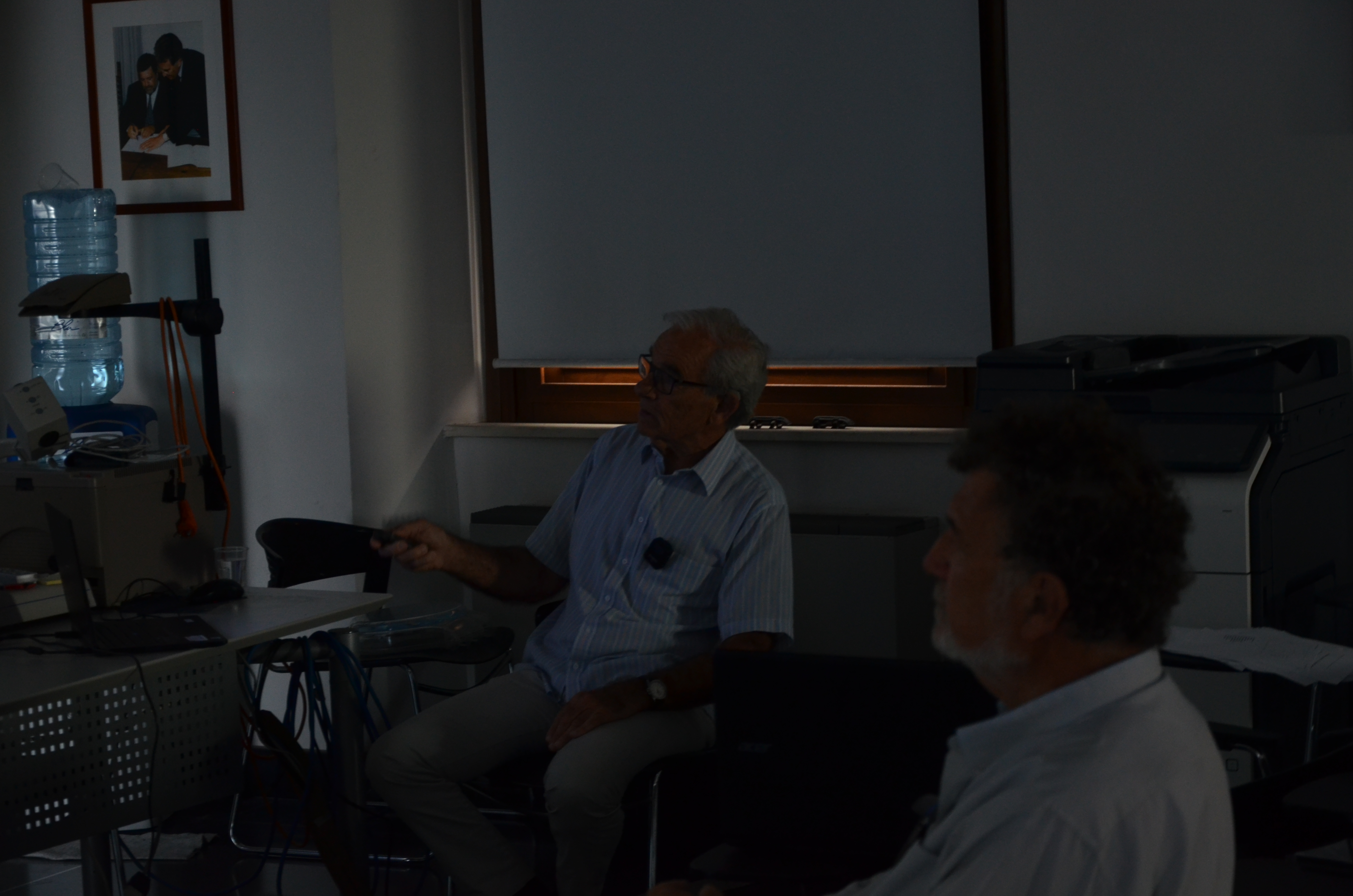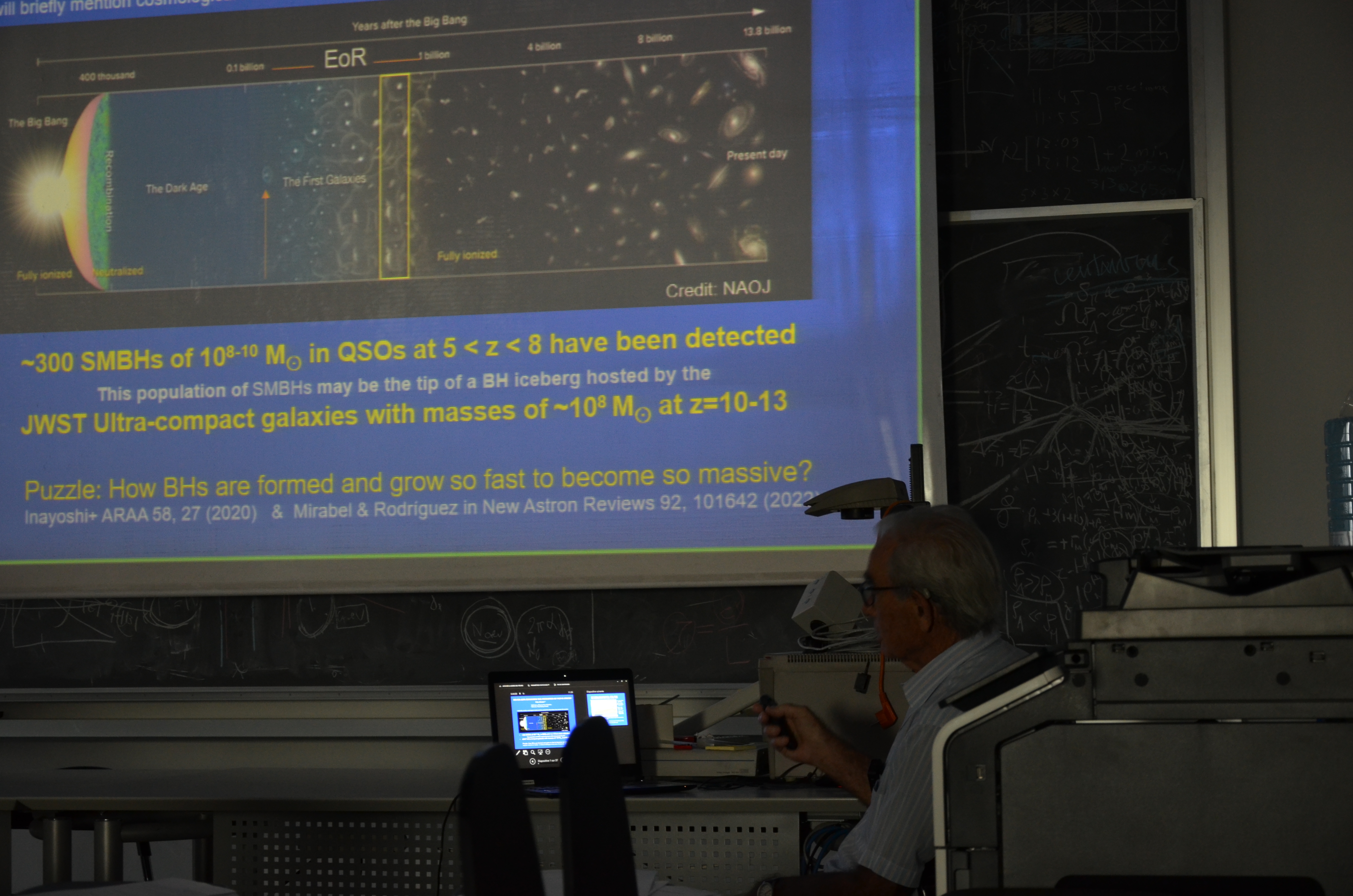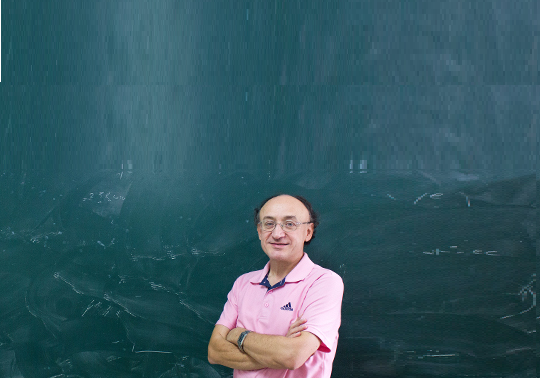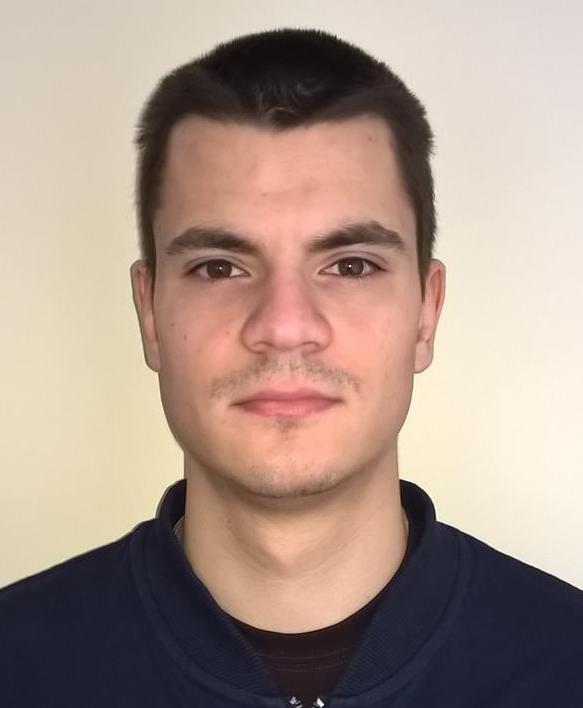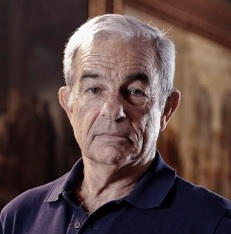

| Newsletter English June-July-August 2023 |

|

|



ICRANet Newsletter
2014 -
2015 -
2016
2017 - 2018 - 2019 2020 - 2021 - 2022 2023 February/March - April/May - June/July/August - September/October
ICRANet Newsletter
June/July/August 2023
SUMMARY
1. ICRA-ICRANET press release “GRB-SN Association within the Binary-Driven Hypernova Model” 2. The 5th Zeldovich meeting, June 12-16, 2023, Yerevan (Armenia) 3. The 18th Italian- Korean Symposium (IK18), June 19 – 23, 2023, Pescara (Italy) 4. ICRANet participation at the “XV International Conference on Gravitation, Astrophysics and Cosmology (ICGAC15)”, July 3-7, 2023, APCTP, Gyeongju (South Korea) 5. ICRANet participation at the meeting “The James Webb Space Telescope turns one: the birth and growth of galaxies”, July 10-14, 2023, Sesto (Italy) 6. New cooperation protocol between ICRANet and Epoka University, June 9, 2023 7. New cooperation protocol between ICRANet and Archimedes ECA, July 31, 2023 8. Renewal of the cooperation protocol between ICRANet and the Universidade Federal da Paraíba(UFPB), June 7, 2023 9. Seminar of Prof. Felix Mirabel at ICRANet center in Pescara, July 27, 2023 10. Scientific visits to ICRANet 11. Recent publications
1. ICRA-ICRANET press release “GRB-SN Association within the Binary-Driven Hypernova Model”
Long gamma-ray bursts (GRBs), in a few seconds, release luminosities (in gamma-rays) comparable to the luminosity of all stars in the observable Universe, which makes them detectable to the dawn of galaxy and stellar formation. One of the most striking observational properties of some of these sources is that they are accompanied by a supernova (SN) of type Ic, traditionally called GRB SN association or connection. The GRB-SN association, probably the most constraining property of GRB theoretical models, is the subject of a new article by an ICRA-ICRANet collaboration, accepted for publication in The Astrophysical Journal [ApJ, 955 (2023) 93]:https://doi.org/10.3847/1538-4357/ace721.
SNe Ic are considered part of the so-called core-collapse SNe, thought to occur in the gravitationalcollapse of the iron core of an evolved star, forming a neutron star (NS). The outer layers are expelledbecause the energy released from the core collapse exceeds their binding energy. On the other hand,long GRBs are mostly thought to be related to events forming stellar-mass black holes (BHs). Therefore,it appears difficult to render the two above theories compatible to produce a GRB-SN by a single object.The new research deepens into this matter, highlighting observational and theoretical facts revealing thepossible role of binaries in these sources. Indeed, it lists some facts that conspicuously evidence thatmost (if not all) GRB-SN should occur in binaries:
From the modeling viewpoint, the publication focuses on the binary-driven hypernova (BdHN) scenario.In the BdHN model, the GRB-SN event occurs in binary composed of a carbon-oxygen (CO) star and anNS companion. The core of the CO star collapses, generating a newborn NS and the supernova. Thesupernova triggers the GRB-observed episodes whose physical processes are scrutinized. The CO-NSfates explain the diversity of GRBs: BdHNe I are the most extreme with energies 1052 –1054 erg. Theirorbital periods are about 5–10 minutes. In these sources, the material ejected in the SN is easily accretedby the NS companion, so it reaches the point of gravitational collapse, forming a rotating BH. In BdHNeII, the orbital period is 20–40 minutes and emit energies 1052 –1054 erg. The accretion is lower, so the NSremains stable. BdHN III have an orbital period of hours, and the accretion is negligible. They explain GRBs with energies lower than 1050 erg. The new article features the BdHN frontier multimessenger physics and astrophysics: emission of neutrinos, gravitational waves, and electromagnetic radiation from the radio to the X-rays, to the gamma-rays, to the GeV, to the TeV, to ultra-high-energy cosmic rays (UHECRs). These occur in seven episodes, identified via time-resolved analysis of observational data, probing new physical ultrarelativistic regimes previously unknown in our galaxy. Attention is given to the first episode, the early SN explosion originating from the 10M⊙ CO core collapse (SN-rise), and to the second episode, the accretion of the SN ejecta on the νNS (νNS-rise). The BH formation occurs by accretion of the SN ejecta on the companion NS, rather than the direct massive star collapse, and originates the associated MeV and GeV emission. The energetics are determined by the rotational energy extraction from a Kerr BH originating overcritical electromagnetic fields leading to an ultra-relativistic expanding e+ e− plasma that loads baryons from the ambient and manifests when it reaches transparency in the third episode, the UPE (ultrarelativistic prompt emission). The corresponding process in the under critical regimes occurring in a test electromagnetic field alignedì with the BH rotation axis leads to the GeV emission, the fourth episode. The fifth Episode addressed the νNS emission with associated synchrotron emission in the X-rays, optical, and radio bands, followed by the sixth and seventh episodes given the Gamma-ray and X-ray flares. The optical radioactive decay of the SN ashes finally follows these seven episodes. Specific examples are given by the SPH simulations performed in collaboration with Los Alamos National Laboratory (see Fig. 1). The energetics of selected BdHNe types and the peak luminosity and time of the 24 SNe are compared and contrasted (see Fig. 2). The cases of two BdHNe I are analyzed in detail (GRB 180720B and GRB 190114C, see Fig. 3). For BdHNe II, the paper describes GRB190829A, and for BdHNe III, GRB171205A. The unveiled details of the GRB episodes auspices a new era: to use the strongest high-energy sources on planet Earth, such as the European Hard X-ray Free Electron Laser (XFEL) operated by DESY at Hamburg and, for the TeV radiation, the accelerators of the European Organization for Nuclear Research (CERN) in Geneva, in order to perform the diagnosis of GRB physics. Reference article: “GRB-SN Association within the Binary-Driven Hypernova Model”; Aimuratov, Y.; Becerra, L. M.; Bianco, C. L.; Cherubini, C.; Della Valle, M.; Filippi, S.; Li, Liang; Moradi, R.; Rastegarnia, F.; Rueda, J. A.; Ruffini, R.; Sahakyan, N.; Wang, Y.; Zhang, S. R.; ApJ, 955 (2023) 93; DOI:https://doi.org/10.3847/1538-4357/ace721
2. The 5th Zeldovich meeting, June 12-16, 2023, Yerevan (Armenia)
The Fifth Zeldovich meeting, organized by ICRANet, is an international conference in honor of Ya. B. Zeldovich, which has been held in Ani Plaza Hotel in Yerevan (Armenia) from June 12 to 16, 2023. This event has also commemorated the 80 th anniversary of the National Academy of Sciences of the Republic of Armenia, whose members gave equally fundamental contributions to the field of Relativistic Astrophysics.
The meeting started on Monday morning, June 12 with the opening remarks by Prof. Remo Ruffini (Director of ICRANet), Prof. Narek Sahakyan (Director of ICRANet Armenia) and H.E. Hakob Arshakyan, Vice President of the Armenian National Assembly, at the presence of eminent authorities, such as H. E. Vahe Gevorgyan, Deputy Minister of Foreign affairs of Armenia, H. E. Ashot Saghyan, President of the Armenian National academy of Sciences, H.E. Avet Poghosyan, Deputy Minister of High-Tech Industry of Armenia, H.E. Alfonso Di Riso, Ambassador of Italy in Armenia, as well as Ms. Nilakshi Saha Sinha, Ambassador of India in Armenia. H.E Arshakyan underlined how Armenia is historically rich in scientific achievements and discoveries, especially in the fields of astrophysics, mathematics and physics. He also emphasized the strong participation of Armenian scientific institutions in similar programs and the leading role played by the Armenian National Academy of Sciences in the field. Deputy Minister Vahe Gevorgyan highlighted the role of ICRANet as an important platform for international cooperation and noted how the organization of this prestigious international conference is an important step for the development of the field of astrophysics not only in Armenia, but also in all participating countries.
During the opening ceremony, the Russian scientist Marat Glifanov accepted the MG16 Marcel Grossmann Award on behalf of the Institute of Space Research (IKI) of the Russian Academy of Sciences. The award was presented by ICRANet Director Remo Ruffini for the Spektr-RG/eROSITA satellite. More than 100 participants from 17 different countries joined the conference and presented, in total, 75 talks on the most relevant recent results on multimessanger astrophysics, early universe, large scale structure, cosmic microwave background, neutron stars, black holes, gamma- ray bursts, supernovae, hypernovae, gravitational waves and quantum and gravity. New results on the leading space projects from space based and ground based astrophysical observatories were also reported, such as: the James Webb Space Telescope JWST (USA), presented by Prof. Massimo Stiavelli and Prof. Garth Illingworth; the radio telescope FAST (China), the X-ray observatory Insight-HXMT (China) as well as the high energy particle observatory LHAASO (China), presented for the first time by Prof. Zha Min, Prof. Li Di and Prof. Shuang-Nan Zhang; the Cherenkov telescopes MAGIC (Germany), the gamma-ray telescope DAMPE (China and Italy), the X-ray polarimeter IXPE (USA and Italy), the X-ray observatory Spektr-RG (Russia and Germany, presented by Prof. Rashid Sunyaev and Prof. Marat Gilfanov of the Russian Academy of Sciences), the network of robotic telescopes MASTER (Russia), the neutrino 8 observatories ICECube (Antarctica) and the Baikal-GVD (Russia) as well as planned missions eXTP (enhanced X-ray Timing and Polarimetry mission) and German-Brazilian-Italian ground-based gamma- ray telescope SWGO.
On the occasion of the conference, the President of the Republic of Armenia H.E. Vahagn Khachaturyan received on Wednesday, June 14 a delegation of participants and organizers of the 5 th Zeldovich meeting. This delegation was composed ofProf. Remo Ruffini, Prof. Narek Sahakyan, Academician Ashot Saghyan (President of the NAS RA), Prof. Shuang-Nan Zhang (Center for Particle Astrophysics, Institute of High Energy Physics, CAS), Prof. Di Li (National Astronomical Observatories, Chinese Academy of Sciences), Prof. Tsvi Piran (the Hebrew University of Jerusalem), Prof. Paolo Soffitta (INAF IAPS) and Prof. Alexei Starobinsky (Landau Institute for Theoretical Physics RAS). President Khachaturyan highly valued the organization of such events and expressed his willingness to support programs and initiatives in the field of science to the best of his ability, stressing the importance of ICRANet activities in Armenia. Prof. Ruffini welcomed cooperation with Armenia and noted that there is an intention to implement new programs with the countries of Central Asia via Armenia. All the interlocutors discussed possibilities of the implementation of joint programs and further deepening of cooperation with the world’s leading centers, organizations, and universities, such as ICRANet.
All the abstracts submitted for the conference have been collected in the book of abstracts, available on the conference website at the following link:https://indico.icranet.org/event/6/book-of-abstract.pdf
The concluding remarks, summarizing the new and important scientific results presented along the meeting, have been made by Prof. Remo Ruffini as well as by Prof. Narek Sahakyan.
The proceedings of the 5th Zeldovich meeting will be published in the refereed journal Astronomy Reports, the leading Russian journal on Astronomy and Astrophysics with high impact factor (for the website of the journal:https://www.springer.com/journal/11444)The editors will be Prof. Remo Ruffini, Prof. Narek Sahakyan and Prof. Gregory Vereshchagin.
This meeting was the fifth international conference dedicated to Ya. B. Zeldovich. The previous meetings were held from April 23 to 27, 2018 in Minsk, from April 20 to 23, 2009 in Minsk (jointly organized by ICRANet and the Belarusian State University BSU, celebrating also the 2009 Year of Astronomy), from March 11 to 14, 2014 (celebrating 100th anniversary of Ya. B. Zeldovich) and from September 7 to 11, 2020 online.
The recordings of all the sessions are available on ICRANet YouTube channel at the following link:https://www.youtube.com/watch?v=cQuXRbnJ6o4&list=PLr5RLbSWSonvawHlYpDVmRJIUoPHtopw7
For the website of the meeting and the speakers’ presentations:http://www.icranet.org/zeldovich5
For the press release on the website of the National Assembly of the Republic of Armenia:http://www.parliament.am/news.php?cat_id=2&NewsID=18950&year=2023&month=06&day=12&lang=arm&e nc=utf8
for the press release on the website of the Public Radio of Armenia http://www.parliament.am/news.php?cat_id=2&NewsID=18950&year=2023&month=06&day=12&lang=arm&enc=utf8
for the press release on the website Armen Presshttps://armenpress.am/eng/news/1113073/
for the press release on the NAS RA websitehttps://www.sci.am/m/newsview.php?id=706&arch=&langid=2
for the press release on the website of the President of the Republic of Armenia https://www.president.am/en/press-release/item/2023/06/14/President-Vahagn-Khachaturyan/
for the video on the YouTube channel of the Armenian Parliament https://www.youtube.com/watch?v=foQYriAY0Ck&t=107s
3. The 18 th Italian- Korean Symposium (IK18), June 19 – 23, 2023, Pescara (Italy)
The 18th Italian-Korean Symposium on Relativistic Astrophysics has been held from June 19 to 23, 2023 at ICRANet center in Pescara and online.The meeting has been co organized by Kunsan National University, CQUeST and Sogang University (on the Korean side) and, on the italian side, by ICRANet. The Italian-Korean Symposia on Relativistic Astrophysics is a series of biannual meetings, alternatively organized in Italy and in Korea since 1987. The main purpose of this symposium is to accelerate the exchange between scientists of Italy and Korea, especially young researchers.
Members of the IK18 Italian Committee are Remo Ruffini (Director of ICRANet, ICRA), Carlo Luciano Bianco (ICRA, ICRANet), Massimo Della Valle (Capodimonte Astronomical Observatory, INAF, ICRANet), Luca Izzo (Capodimonte Astronomical Observatory, INAF), Paolo Giommi (ASI), Roy Patrick Kerr (ICRANet), Liang Li (ICRANet), Rahim Moradi (ICRANet), Jorge A. Rueda H. (ICRANet, University of Ferrara), Narek Sahakyan (Director of ICRANet center in Armenia), Gregory Vereshchagin (ICRANet), Yu Wang (ICRANet) and Shesheng Xue (ICRANet). Members of IK18 Korean Committee are Stefano Scopel (CQUeST, Sogang University), Bum-Hoon Lee (CQUeST, Sogang University), Sang Pyo Kim (Kunsan National University), Sung-WonKin (Ehwa University), Wonwoo Lee (CQUeST, Sogang University), Hyeong Chan Kim (AIP) and Lee Heongwon.
The topics addressed during the IK symposia have been, traditionally, astrophysics and cosmology, gamma-ray bursts, compact starts high energy cosmic rays, dark energy and dark matter, general relativity, black holes and new physic related to cosmology. This year, the focus has been on the irriducible mass, the gravitational wave emission from GRBs as well as the ellipsoidal configurations of equilibrium in General Relativity. The most recent scientific developments were presented by eminent Professors and researchers.
The opening remarks have been presented by Prof. Remo Ruffini and Prof. Stefano Scopel. The speakers were Prof. Dong-Hoon Kim, Prof. Wonwoo Lee, Prof. Sang Pyo Kim, Prof. Stefano Scopel, Prof. Dong-hun Lee, Prof. Chanyong Park, Prof. Chan Park, Prof. Bum-Hoon Lee, Prof. Sung-Won Kim, Prof. Remo Ruffini, Prof. Carlo Luciano Bianco, Prof. Gregory Vereshchagin, Prof. Massimo Della Valle, Prof. Lorenzo Amati, Prof. JorgeRueda, Prof. Rahim Moradi, Prof. Yu Wang, Prof. Antonio Enea Romano, Shurui Zhang, Dr Josè Fernando Rodriguez Ruiz, Prof. Shesheng Xue, Prof. Muhammad Sharif and Abdel Nasser Tawfik.
For more information about the meeting, please see: https://indico.icranet.org/event/7/
4. ICRANet participation at the “XV International Conference on Gravitation, Astrophysics and Cosmology (ICGAC15)”, July 3-7, 2023, APCTP, Gyeongju (South Korea)
On July 7, 2023, Prof. Ruffini (Director of ICRANet) has been invited to present a plenary lecture on the occasion of the 2023 edition of the International Conference on Gravitation, Astrophysics and Cosmology (ICGAC15), held in Gyeongju (South Korea) and online from July 3 to 7, 2023.
On Friday July 7, Prof. Ruffini presented his plenary lecture titled “GRB 220101A: the most powerful GRB with seven BdHN Episodes observed”.
Prof. Ruffini was also a member of ICGAC15 International Standing Committee, International Advisory Committee and Scientific Committee.
ICGAC is the series of triennial conferences on Gravitation, Astrophysics and Cosmology which take place in the Asia- Pacific region, with the goals to promote cooperation among the member countries and within an international context, high level studies on hot topics and to encourage young physicists on these fields. This conference has been one of the key programs sponsored by APCTP over the past twenty years and has been hosted by AP regions: Seoul, Korea (1993); Hsinchu, Taiwan (1995); Tokyo, Japan(1997); Beijing, China (1999); Moscow, Russia (2001); Seoul, Korea (2003); Jhongli, Taiwan (2005); Nara, Japan (2007); Wuhan, China (2009); Qui-Nhon, Vietnam (2011); Almaty, Kazakhstan (2013); Moscow, Russia (2015), Seoul, Korea (2017) and Taiwan (2020).
The main topics covered during the ICGAC15 meeting included classical Gravity and GR Extensions, Classical and Quantum Cosmology, Dark Matter and Dark Energy, Black Holes, Wormholes, Strings, Branes, Higher Spin Fields and Quantum Gravity, extra Dimensions and Variation of Constants, Experimental Studies of Gravity and Fundamental Physics Space Projects, Gravitational Waves, Multi Messenger Astronomy, Numerical Relativity, Relativistic Astrophysics, White Dwarfs, Neutron Stars and Gamma Ray Bursts, Alternative Theory and Education.
For the website of the meeting: https://www.apctp.org/theme/d/html/activities/activities01_read-pop.php?id=1801&m_id=212
5. ICRANet participation at the meeting “The James Webb Space Telescope turns one: the birth and growth of galaxies”, July 10-14, 2023, Sesto (Italy)
On July 10, 2023, Prof. Remo Ruffini (Director of ICRANet) took part in opening day of the meeting “The James Webb Space Telescope turns one: the birth and growth of galaxies”, which has been held from July 10 to 14 in the Sexten Center for Astrophysics Riccardo Giacconi (Italy)
One year after the release of the first data of the James Webb Space Telescope, the meeting aimed to gather relevant scientist, researchers and students to discuss the transformative science enabled by Webb's observations in the field of galaxy formation and evolution, from its earliest stages to more mature phases in cosmic history. The main topics covered during the meeting were the process from the first stars to the current star formation, the dust and circum-galactic medium in distant galaxies, the reionization history, the galaxy mass growth and early morphological evolution, as well as the AGN activity at high redshift.
After the opening ceremony, the first day of the meeting was mainly devoted to a presentation on the status and the overview of results of the JWST, as well as on the first results on Early galaxy formation and evolution from the JWST surveys.
For the website of the meeting: https://www.sexten-cfa.eu/event/jwebb23/
6. New cooperation protocol between ICRANet and Epoka University, June 9, 2023
On June 9, 2023 ICRANet has signed a new Cooperation protocol with the Epoka University in Albania. The Cooperation Protocol has been signed by Prof. Ahmet Öztaş (Rector of Epoka University), by Prof. Arban Uka (Epoka University), by Prof. Remo Ruffini (Director of ICRANet) and by Prof. Jorge A. Rueda (ICRANet Faculty Professor).
The agreement will be valid for 5 years and the main joint activities to be developed under their framework include: the promotion of theoretical and observational activities within the field of Relativistic Astrophysics; the institutional exchange of faculty members, researchers, post-doctorate fellows and students; the promotion of technological developments; the development of Data Centers for Astrophysical data in all wavebands; the organization of training and teaching courses, seminars, conferences, workshops or short courses, the development of inter-institutional research areas associated to local graduate programs and joint publications
For the text of the agreement: http://www.icranet.org/index.php?option=com_content&task=view&id=1493
7. New cooperation protocol between ICRANet and Archimedes ECA, July 31, 2023
On July 31, 2023 ICRANet has signed a new Cooperation protocol with the association Archimedes ECA in France. The Cooperation Protocol has been signed by Prof. Joseph Kouneiher (President of Archimedes ECA) and by Prof. Remo Ruffini (Director of ICRANet).
The agreement will be valid for 5 years and the main joint activities to be developed under their framework include: the promotion of theoretical and observational activities within the field of Relativistic Astrophysics; the institutional exchange of faculty members, researchers, post-doctorate fellows and students; the promotion of technological developments; the development of Data Centers for Astrophysical data in all wavebands; the organization of training and teaching courses, seminars, conferences, workshops or short courses, the development of inter-institutional research areas associated to local graduate programs and joint publications.
For the text of the agreement: http://www.icranet.org/index.php?option=com_content&task=view&id=1499
8. Renewal of the cooperation protocol between ICRANet and the Universidade Federal da Paraíba (UFPB), June 7, 2023
On June 7, 2023, the Cooperation Protocol between ICRANet and the Universidade Federal da Paraíba (UFPB) has been renewed. The renewal was signed by Prof. Valdiney Neloso Gouveia (Rector of UFPB) and by Prof. Remo Ruffini (Director of ICRANet). This agreement will be valid for further 5 years and the main joint activities to be developed under its framework include: the promotion of theoretical and observational activities within the field of Relativistic Astrophysics; the institutional exchange of faculty members, researchers, post-doctorate fellows and students; the promotion of technological developments; the development of Data Centers for Astrophysical data in all wavebands; the organization of training and teaching courses, seminars, conferences, workshops or short courses, the development of inter- institutional research areas associated to local graduate programs and joint publications.
For the text of the agreement: http://www.icranet.org/index.php?option=com_content&task=view&id=1019
9. Seminar of Prof. Felix Mirabel at ICRANet center in Pescara, July 27, 2023
On Thursday, July 27, 2023, Prof. Felix Mirabel (IAFE-University of Buenos Aires and CEA-Saclay) presented a seminar titled “Did Black hole-jets enhancedthe formation of Pop-III stars at cosmic dawn?” with the following abstract:
The existence of supermassive black holes (SMBHs) of 10^9 solar masses in quasars at cosmic ages of less than 700 Myr is an intriguing puzzle. How the seeds of these SMBHs have formed and grown so fast to become so large? Models of the compact seeds of the SMBHs observed at redshifts z > 6 propose in the context of dark matter cosmologies those seeds are formed by direct collapse in dark matter haloes. I will show that recent high-z ALMA and JWST observations are consistent with the astrophysical hypotheses in those models. Finally, integrating those recent theoretical and observational contexts, with past extensive studies of the environments of BH-jets in the local and distant universe, I will conclude that the relativistic jets and associated massive outflows from rapidly growing BHs at cosmic dawn must have enhanced the formation of Pop-III massive stars.
The announcement of the seminar has also been published on ICRANet website:https://www.icranet.org/index.php?option=com_content&task=blogcategory&id=89&Itemid=781
for the video of the seminar https://www.youtube.com/watch?v=H9_cGdVT35A
10. Scientific visits to ICRANet
During their visit, those scientists had an opportunity to discuss their scientific research and to have fruitful exchange of ideas with other researchers from ICRANet and from different parts of the world.
11. Recent publications
Y. Aimuratov, L. M. Becerra, C.L. Bianco, C. Cherubini, M. Della Valle, S. Filippi, Liang Li, R. Moradi, F. Rastegarnia, J. A. Rueda, R. Ruffini, N. Sahakyan, Y. Wang, S. R. Zhang, GRB-SN Association within the Binary-Driven Hypernova Model, accepted for publication in The Astrophysical Journal.
The observations of supernovae (SNe) Ic occurring after the prompt emission of long gamma-ray bursts (GRBs) are addressed within the binary-driven hypernova (BdHN) model where GRBs originate from a binary composed of a ∼10M ⊙ carbon-oxygen (CO) star and a neutron star (NS). The CO core collapse gives the trigger, leading to a hypernova with a fast-spinning newborn NS (νNS) at its center. The evolution depends strongly on the binary period, Pbin. For Pbin∼5min, BdHNe I occur with energies 1052 -1054 erg. The accretion of SN ejecta onto the NS leads to its collapse, forming a black hole (BH) originating the MeV/GeV radiation. For Pbin∼10min, BdHNe II occur with energies 1050 -1052 erg and for Pbin∼hours, BdHN III occurs with energies below 1050 erg. {In BdHNe II and III,} no BH is formed. The 1-1000ms νNS originates, in all BdHNe, the X-ray-optical-radio afterglows by synchrotron emission. The hypernova follows an independent evolution, becoming an SN Ic, powered by nickel decay, observable after the GRB prompt emission. We report 24 SNeIc associated with BdHNe. Their optical peak luminosity and time of occurrence are similar and independent of the associated GRBs. {From previously identified 380 BdHN I comprising redshifts up to z=8.2, we analyze} four examples with their associated hypernovae. By multiwavelength extragalactic observations, we identify seven new Episodes, theoretically explained, fortunately not yet detected in galactic sources, opening new research areas. Refinement of population synthesis simulations is needed to map the progenitors of such short- lived binary systems inside our galaxy.
Antonio Enea Romano, Mairi Sakellariadou, Mirage of Luminal Modified Gravitational-Wave Propagation, publish in Phys. Rev. Lett. 130, 231401 on June 8, 2023.
Using conformal invariance of gravitational waves, we show that for a luminal modified gravity theory, the gravitational-wave propagation and luminosity distance are the same as in general relativity. The relation between the gravitational-wave and electromagnetic-wave luminosity distance gets modified, however, for electromagnetism minimally coupled to the Jordan frame metric. Using effective field theory we show that the modified relation obtained for luminal theories is also valid for nonluminal theories with Jordan frame matter-gravity coupling. We generalize our analysis to a time-dependent speed of gravitational waves with matter minimally coupled to either the Jordan or Einstein frame metrics.
Laura M. Becerra, Chris Fryer, Jose F. Rodriguez, Jorge A. Rueda and Remo Ruffini, Neutron Star Binaries Produced by Binary-Driven Hypernovae, Their Mergers, and the Link between Long and Short GRBs, published in Universe 2023, 9(7), 332 on July 12, 2023.
The binary-driven hypernova (BdHN) model explains long gamma-ray bursts (GRBs) associated with supernovae (SNe) Ic through physical episodes that occur in a binary composed of a carbon-oxygen (CO) star and a neutron star (NS) companion in close orbit. The CO core collapse triggers the cataclysmic event, originating the SN and a newborn NS (hereafter 𝜈𝜈NS) at its center. The 𝜈𝜈NS and the NS accrete SN matter. BdHNe are classified based on the NS companion fate and the GRB energetics, mainly determined by the orbital period. In BdHNe I, the orbital period is of a few minutes, so the accretion causes the NS to collapse into a Kerr black hole (BH), explaining GRBs of energies >1052 erg. BdHN II, with longer periods of tens of minutes, yields a more massive but stable NS, accounting for GRBs of 1050 –1052 erg. BdHNe III have still longer orbital periods (e.g., hours), so the NS companion has a negligible role, which explains GRBs with a lower energy release of <1050 erg. BdHN I and II might remain bound after the SN, so they could form NS-BH and binary NS (BNS), respectively. In BdHN III, the SN likely disrupts the system. We perform numerical simulations of BdHN II to compute the characteristic parameters of the BNS left by them, their mergers, and the associated short GRBs. We obtain the mass of the central remnant, whether it is likely to be a massive NS or a BH, the conditions for disk formation and its mass, and the event’s energy release. The role of the NS nuclear equation of state is outlined.
Jonas P. Pereira and Jorge A. Rueda, Matching Slowly Rotating Spacetimes Split by Dynamic Thin
Shells, published in Universe 2023, 9(7), 305 onJune 24, 2023.
We investigated within the Darmois–Israel thin-shell formalism the match of neutral and asymptotically
flat, slowly rotating spacetimes (up to second order in the rotation parameter) when their boundaries are
dynamic. It has several important applications in general relativistic systems, such as black holes and
neutron stars, which we exemplify. We mostly focused on the stability aspects of slowly rotating thin
shells in equilibrium and the surface degrees of freedom on the hypersurfaces splitting the matched
slowly rotating spacetimes, e.g., surface energy density and surface tension. We show that the stability
upon perturbations in the spherically symmetric case automatically implies stability in the slow rotation
case. In addition, we show that, when matching slowly rotating Kerr spacetimes through thin shells in
equilibrium, the surface degrees of freedom can decrease compared to their Schwarzschild counterparts,
meaning that the energy conditions could be weakened. The frame-dragging aspects of the match of
slowly rotating spacetimes are also briefly discussed.
Vitaliy Kim, Adel Umirbayeva and YerlanAimuratov, Estimates of the Surface Magnetic Field
Strength of Radio Pulsars, published in Universe 2023, 9(7), 334 on July 14, 2023.
We investigate the geometry of the magnetic field of rotation-powered pulsars. A new method for
calculating an angle (𝛽𝛽) between the spin and magnetic dipole axes of a neutron star (NS) in the ejector
stage is considered within the frame of the magnetic dipole energy loss mechanism. We estimate the
surface magnetic field strength (𝐵𝐵ns) for a population of known neutron stars in the radio pulsar
(ejector) stage. The evaluated 𝐵𝐵ns(𝛽𝛽) may differ by an order of magnitude from the values without
considering the angle 𝛽𝛽. It is shown that 𝐵𝐵ns(𝛽𝛽) lies in the range 108 –1014G for a known population of
short and middle periodic radio pulsars.
Mikalai Prakapenia, Gregory Vereshchagin, Pauli blocking effects on pair creation in strong
electric field, published in Phys. Rev. D 108, 013002 on July12, 2023.
The process of electron-positron pair creation and oscillation in a uniform electric field is studied, taking
into account the Pauli exclusion principle. Generally, we find that pair creation is suppressed; hence,
coherent oscillations occur on longer timescales. Considering pair creation in already existing electron-
positron plasma, we find that the dynamics depends on pair distribution function. We considered Fermi-
Dirac distribution of pairs and found that for small temperatures pair creation is suppressed, while for
small chemical potentials it increases: heating leads to enhancement of pair creation.
Roohollah Mohammadi, Jafar Khodagholizadeh, Mahdi Sadegh, Ali Vahedi, She-sheng Xue,
Cross-correlation Power Spectra and Cosmic Birefringence of the CMB via Photon-neutrino
Interaction, published in JCAP 06 (2023) 044 onJune 20, 2023.
In the context of the standard model of particles, the weak interaction of cosmic microwave background (CMB) and cosmic neutrino background (CνB), can generate non-vanishing TB and EB power spectra in the order of one loop forward scattering, in the presence of scalar perturbation, which is in contrast with the standard scenario cosmology. Comparing our results with the current experimental data may provide, significant information about the nature of CνB, including CMB-CνB forward scattering for TB, TE, and EB power spectra. To this end, different cases were studied, including Majorana CνB and Dirac CνB. On the other hand, it was shown that the mean opacity due to cosmic neutrino background could behave as an anisotropic birefringent medium and change the linear polarization rotation angle. Considering the contributions from neutrino and anti-neutrino forward scattering with CMB photons (in the case of Dirac neutrino), we introduce relative neutrino and anti-neutrino density asymmetry (δν = Δnν/nν = nν-n-ν/nν). Then, using the cosmic birefringence angle reported by the Planck data release β = 0.30° ± 0.11° (68%C.L.), some constraints can be put on δν. Also, the value of cosmic birefringence due to Majorana CνB medium is estimated at about β|ν≃ 0.2 rad. In this respect, since Majorana neutrino and anti-neutrino are exactly the same, both CB contributions will be added together. However, this value is at least two orders larger than the cosmic birefringence angle reported by the Planck data release, β = 0.30° ± 0.11° (68%C.L.). Finally, we shortly discussed this big inconsistency. It is noteworthy that to calculate the contribution of photon-neutrino forward scattering for cosmic birefringence, we just consider the standard model of particles and the standard scenario of cosmology.
She-Sheng Xue, Massive particle pair production and oscillation in Friedman Universe: reheating
energy and entropy, and cold dark matter, published in Eur. Phys. J. C (2023) 83: 355.
Suppose that the early Universe starts with a cosmological Λ-term originating from quantum spacetime at the Planck scale. Dark energy drives inflation and reheating by reducing its value for massive particle-antiparticle pairs production and oscillation, resulting in a holographic and massive pair plasma state. The back-and-forth reaction of dark energy and massive pairs slows inflation to its end and starts reheating by rapidly producing stable and unstable pairs. We introduce the Boltzmann-type rate equation describing the back-and-forth reaction. It forms a close set with Friedman equations and reheating equations for unstable pairs decay to relativistic particles. The numerical solutions show preheating, massive pairs dominated and genuine reheating episodes. We obtain the reheating temperature and entropy in terms of the tensor-to-scalar ratio 0c∼10−1 is about a constant in time.
Argüelles, C. R.; Boshkayev, K.; Krut, A.; Nurbakhyt, G.; Rueda, J. A.; Ruffini, R.; Uribe-
Suárez, J. D.; Yunis, R., On the growth of supermassive black holes formed from the gravitational
collapse of fermionic dark matter cores, published in Monthly Notices of the Royal Astronomical
Society, Volume 523, Issue 2 on August 2023.
Observations support the idea that supermassive black holes (SMBHs) power the emission at the centre of active galaxies. However, contrary to stellar-mass BHs, there is a poor understanding of their origin and physical formation channel. In this article, we propose a new process of SMBH formation in the early Universe that is not associated with baryonic matter (massive stars) or primordial cosmology. In this novel approach, SMBH seeds originate from the gravitational collapse of fermionic dense dark matter (DM) cores that arise at the centre of DM haloes as they form. We show that such a DM formation channel can occur before star formation, leading to heavier BH seeds than standard baryonic channels. The SMBH seeds subsequently grow by accretion. We compute the evolution of the mass and angular momentum of the BH using a geodesic general relativistic disc accretion model. We show that these SMBH seeds grow to ∼109–1010M⊙ in the first Gyr of the lifetime of the Universe without invoking unrealistic (or fine-tuned) accretion rates.
B. Eslam Panah, Three-dimensional energy-dependent C-metric: black hole solutions, published in
Physics Letters Bon August 19, 2023.
Considering a three-dimensional C-metric and adding energy-dependent to this spacetime, we first
create a three-dimensional energy-dependent C-metric. Then, we extract accelerating BTZ black hole
solutions in gravity's rainbow. Besides, we show that (A)dS black holes cover by an event horizon that
depends on all the parameters of this theory. Using the definition of Hawking temperature, we obtain the
temperature of these black holes and study the effects of various parameters on this quantity. We find a
critical radius in which the temperature is always positive (negative) before (after) it. Then, we obtain
the entropy of such black holes. Our analysis indicates that there is the same behavior for entropy,
similar to the temperature. Indeed, before (after) the critical radius, the entropy is positive (negative). In
order to study the local stability of such black holes, we calculate the heat capacity. We find two
different behaviors for the heat capacity, which depend on the cosmological energy-dependent constant.
As a final result, accelerating AdS BTZ black holes can satisfy the physical condition and local stability
at the same time.
Li Liang, Revisiting the Spectral Energy Correlations of GRBs with Fermi Data. I. Model-wise
Properties, published in The Astrophysical Journal Supplement Series, Volume 266, Number 2 on
June 5, 2023.
Gamma-ray bursts (GRBs) exhibit a diversity of spectra. Several spectral models (e.g., Band, cutoff power law (CPL), and blackbody) and their hybrid versions (e.g., Band+blackbody) have been widely used to fit the observed GRB spectra. Here, we attempt to collect all the bursts detected by Fermi/GBM with known redshifts from 2008 July to 2022 May, having been motivated to (i) provide a parameter catalog independent of the official Fermi/GBM team and (ii) achieve a "clean" model-based GRB spectral energy correlation analysis. A nearly complete GRB sample is created, containing 153 such bursts (136 long GRBs and 17 short GRBs). Using the sample and by performing detailed spectral analysis and model comparisons, we investigate two GRB spectral energy correlations: the correlation of the cosmological rest-frame peak energy (Ep,z) of the νFν prompt emission spectrum with (i) the isotropic-bolometric-equivalent emission energy Eγ,iso (the Amati relation) and (ii) the isotropic-bolometric-equivalent peak luminosity Lp,iso (the Yonetoku relation). From a linear regression analysis, a tight correlation between Ep,z and Eγ,iso (and Lγ,iso) is found for both Band-like and CPL-like bursts (except for CPL-like long burst Ep,z–Eγ,iso correlation). More interestingly, CPL-like bursts do not fall on the Band-like burst Amati and Yonetoku correlations, suggesting distinct radiation processes, and pointing to the fact that these spectral energy correlations are tightly reliant on the model-wise properties.
Gómez, Gabriel; Rodríguez, José F., New non-Abelian Reissner-Nordström black hole solutions in
the generalized SU(2) Proca theory and some astrophysical implications, published in Phys. Rev. D
108, 024069 on July 31, 2023.
The generalized SU(2) Proca theory is a vector-tensor theory of gravity whose action is invariant under
global transformations of the SU(2) group and includes second-order derivative self-interactions of the
vector field beyond the massive Yang-Mills theory. We find, in particular, that the presence of two
Lagrangian pieces consisting of four gauge fields minimally coupled to gravity gives rise to an exact
Reissner-Nordström black hole solution endowed with two different non-Abelian effective charges that
depend on the specific combination χ=2χ1+χ2 of the respective coupling constants. After studying the
spacetime structure of the black hole, which allows us to characterize the parameter space that preserves
the weak cosmic censorship conjecture, some astrophysical implications of the black hole solutions are
investigated. First, joint analysis of observations of the Event Horizon Telescope’s first images of
Sagittarius A⋆ of our Galaxy and the Keck telescope set the first serious constraint on the free
parameters of the theory beyond the theoretical bounds found. Second, we investigate the accretion
properties of spherical steady flows around this class of non-Abelian Reissner-Nordström black hole.
Specifically, we examine the general conditions under which transonic flow is allowed. An analytical
solution for critical accretion is found in terms of the coupling constant. In addition, we explore the
effect of changing χ on the radial velocity and mass density numerically and show how the extremal
Reissner-Nordström and the standard Schwarzschild solutions as limit cases are achieved. Finally,
working in the fully relativistic regime, an analytical expression for the critical mass accretion rate of a
polytropic fluid onto a black hole is derived. As a main result, we find that the critical accretion rate
efficiency can be noticeably improved compared to the Schwarzschild case for a specific region of the
parameter space where the non-Abelian charge becomes imaginary.
|
||||||||||||||||||||||||||||||||||||||||||||||
|
||
